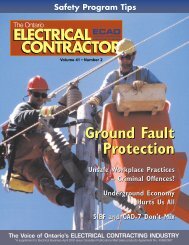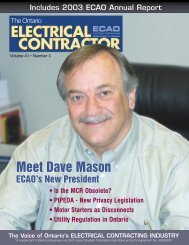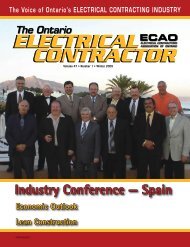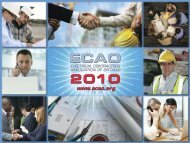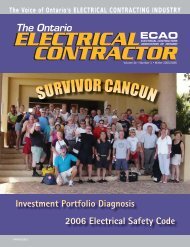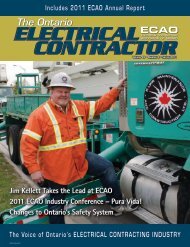Prompt Payment Legislation - Electrical Contractors Association of ...
Prompt Payment Legislation - Electrical Contractors Association of ...
Prompt Payment Legislation - Electrical Contractors Association of ...
- No tags were found...
You also want an ePaper? Increase the reach of your titles
YUMPU automatically turns print PDFs into web optimized ePapers that Google loves.
C4, 6215 - 3rd Street S.E.Calgary, AB T2H 2L2Comprehensive TechnicalServicesAinsworth will help you improve the efficiency <strong>of</strong>your buildings and find the right solutions for allyour infrastructure needs. We provide fast, reliableservice, maintenance and installation for• Chillers• Air Conditioning & Heating• Plumbing• <strong>Electrical</strong>• Motors & Motor Rewind• Data CommunicationImprove infrastructure efficiency using oursolutions for• Design Build• Energy Services• Power Systems• Mechanical & <strong>Electrical</strong> Projects• Facility Management• Equipment MaintenanceAinsworth has been taking care <strong>of</strong> customers andproviding comprehensive technical services formore than 75 years.24 Hour Emergency Service1 866 - GO ACTION (462-2846)www. ainsworth.comToronto • Mississauga • Hamilton/Niagara • Cambridge • Vancouver • Calgary • Edmonton • Regina • Saskatoon• Winnipeg • HalifaxAINSWORTH INC.131 Bermondsey Road, Toronto, Ontario M4A 1X4 Tel. (416) 751-4420 Fax: (416) 751-9031 www.ainsworth.com
This is no placeto find outyou’re not wearingDuPont TM Protera. ®There’s only one Protera ® fibre, and it’s made by DuPont. That’s why electrical workersand the people who protect them insist on the genuine article. They know situationscan change in a flash. DuPont Protera ® gives your crew built-in protection that meetsNFPA 70E Category 2 standards. The superior electric arc protection <strong>of</strong> garments madewith Protera ® can’t be washed or worn away and <strong>of</strong>fers better life-cycle value thanFR-treated cotton or cotton/nylon blends. And Protera ® garments were rated morecomfortable in a double-blind test than FR-treated blends, so your people can focuson the task at hand. Surround your pr<strong>of</strong>essionals with the material that’s testedand proven by the thermal specialists and engineers who created DuPont Nomex . ®Visit personalprotection.dupont.caB EP R O T E R A ®R E A D Y.Copyright © 2010 DuPont. All rights reserved. The DuPont Oval Logo, DuPont TM , The miracles <strong>of</strong> science TM , Protera ® and Nomex ®are registered trademarks or trademarks <strong>of</strong> E. I. du Pont de Nemours and Company. DuPont Canada is a licensee.
Are you BeING Protectedas per NFPA 70e?the canadian standard is cSA-Z 462Did you know MILLWORKSManufacturing used to beknown as CarharttCanada Limited?Meets ASTM 1506-02for flame resistancyWe’ve Got YouCovered FromHead to Toe
IBEW ConstructionCouncil <strong>of</strong> OntarioJohn Grimshaw - Executive Secretary-TreasurerJack Dowding - Executive ChairmanJames Barry - PresidentBruce McNamara - Vice-President and Power Council PresidentRepresenting 13 IBEW Local Unions across the Province <strong>of</strong> Ontarioserving over 14,000 Electricians, Communication Workers and LinemenIBEW CONSTRUCTIONCOUNCIL OF ONTARIO209-61 International Blvd.Toronto ON M9W 6K4tele: 416-674-6940105 HAMILTONLorne Newick, B.M.Vic Prohaska, Pres.tele: 905-387-1721115 KINGSTONBill Pearse, B.M.Guy Desaulniers, Pres.tele: 613-547-4115120 LONDONJohn Gibson, B.M.Steve Carty, Pres.tele: 519-451-0655303 ST. CATHARINESPeter Wall, B.M.Rob Wall, Pres.tele: 905-354-4303353 TORONTOSteve Martin, B.M.Robert White, Pres.George Smith, Rec. Sec.tele: 416-510-3530402 THUNDER BAYGlen Drewes, B.M.Gary McMahon, Pres.tele: 807-623-5759586 OTTAWAJames Barry, B.M.Douglas Parsons, Pres.tele: 613-741-5664773 WINDSORSol Furer, B.M.Karl Lovett, Pres.tele: 519-948-2221804 KITCHENERGeorge Couch, B.M.Mark Watson, Pres.tele: 519-742-8319894 OSHAWATerry Dorgan, B.M.Randy O’Neill, Pres.tele: 905-623-79311687 SUDBURYBruce McNamara, B.M.Timothy Butler, Pres.tele: 705-566-16871739 BARRIETom Leduc, B.M.Jeff Banks, Pres.tele: 705-734-9590INTERNATIONAL OFFICEPhil Flemming, IVPtele: 905-564-5441530 SARNIAMick Cataford, B.M.Raphael Camden, Pres.tele: 519-344-4154
The President’s RemarksJim KellettThe President’s Remarks<strong>Prompt</strong><strong>Payment</strong> <strong>Legislation</strong>IIn these “Remarks” I want to do something different than describethis edition <strong>of</strong> the Ontario <strong>Electrical</strong> Contractor. I want to educate youand sell you on a great idea and hopefully get your support to achieveit. That idea is <strong>Prompt</strong> <strong>Payment</strong> <strong>Legislation</strong> (PPL). What is it? Simplylegislation which mandates regular timely payment for constructionwork performed and remedies like interest penalties or legal workstoppage if not paid.The ECAO is a member and the manager <strong>of</strong> the Canadian <strong>Electrical</strong><strong>Contractors</strong> <strong>Association</strong> (CECA), which in turn is a foundingmember <strong>of</strong> the National Trade <strong>Contractors</strong> Coalition <strong>of</strong> Canada(NTCCC). Through this network <strong>of</strong> relationships we are able toprovide comprehensive and independent representation <strong>of</strong> tradecontractor issues at all jurisdictional levels. The primary interest <strong>of</strong>these organizations is to promote improvements to the paymentsystem in construction to the benefit, firstly, <strong>of</strong> trade contractors, butalso for the entire construction contracting chain.Over the past couple <strong>of</strong> years the focus has become more precise,targeting on the promotion <strong>of</strong> CCA/CCDC standard contracts,documents and guides, and the enactment <strong>of</strong> prompt paymentlegislation similar to other jurisdictions such as the U.K., Australiaand the USA. [See David Zurawel’s article about PPL in the USA onpage 10]. Now these two objectives are merged together as it becomesclear to us that promotion <strong>of</strong> standard contracts and prompt paymentare not just complementary…they are the same.In Ontario the NTCCC in partnership with the Council <strong>of</strong> OntarioConstruction <strong>Association</strong>s (COCA) lobbied the provincial politicalparties about prompt payment throughout the year running up to theOctober 6th election. The first significant breakthrough came in June2011 with the introduction <strong>of</strong> a private member’s bill by Liberal MPPDave Levac on the last day <strong>of</strong> the legislature prior to the election. TheBill was based on similar American legislation and was entitled “AnAct to protect contractors by requiring prompt payment <strong>of</strong> constructioncontracts.” While it’s true the Bill died on the order paper, four thingsgot accomplished:• Legislated prompt payment provisions for construction became arealistic objective;• All three political parties announced their support for promptpayment for construction during the course <strong>of</strong> the electioncampaign;• The trade press and other construction associations like theCanadian Construction <strong>Association</strong> (CCA) and the OntarioGeneral <strong>Contractors</strong> <strong>Association</strong> (OGCA) became actively engagedin the prompt payment debate and dialogue;• The trade contractor community recognized that legislated promptpayment must be consistent with the CCA/CCDC standardcontracts, both prime and subcontract, to gain full industrysupport.During the summer, the impetus from Dave Levac’s private membersbill brought the general and trade contractors together in an agreementto achieve prompt payment legislation which would meet the interests<strong>of</strong> both generals and subs and would be consistent with CCA/CCDCstandard contracts. The job <strong>of</strong> drafting that document was assignedto the Canadian <strong>Electrical</strong> <strong>Contractors</strong> <strong>Association</strong> (and ECAO) whoretained Geza Banfai <strong>of</strong> Heenan Blaikie LLP and also <strong>of</strong> the CCDC.After a number <strong>of</strong> drafts, focus groups and revisions, the draft PPLwas approved by the NTCCC on October 5 and turned over to theOGCA for their review and comment. Official endorsement from theOGCA followed 3 weeks later.The NTCCC has since visited most provinces delivering theirprompt payment message and receiving strong support from thetrade contractor communities there. In some instances the meetingsprompted the establishment <strong>of</strong> provincial trade contractor coalitionssimilar to NTCCC. It seems the national dialogue has begun.At the time <strong>of</strong> writing these “Remarks”, the Ontario constructionindustry is on the verge <strong>of</strong> launching a full on campaign to makeprompt payment a legislated reality. This is ground breaking on somany levels. It validates the importance and relevance <strong>of</strong> standarddocuments, guides and best practices to the real world; it defines tradecontractors as a significant, independent force in construction; and, itprovides an opportunity for the entire industry to work as a unit forthe benefit <strong>of</strong> all constituents.ECAO is completely committed to the enactment <strong>of</strong> prompt paymentlegislation in Ontario and looks to each electrical contractor, memberor not, for their support.Ontario <strong>Electrical</strong> Contractor8
JURISDICTIONAL OVERVIEWA JurisdictionalOverview<strong>of</strong> <strong>Prompt</strong> <strong>Payment</strong>By David Zurawel<strong>Legislation</strong> in the United StatesPrepared for the National Trade <strong>Contractors</strong> Coalition <strong>of</strong> Canada (NTCCC) bythe Council <strong>of</strong> Ontario Construction <strong>Association</strong>s (COCA), August, 2011.Executive Summary• Despite ongoing fundamental differences, the American general,sub and specialty contractor community have collectively recognizedthe importance and benefits <strong>of</strong> a prompt payment culture forconstruction.• The broader construction industry in the United States recognizesthree fundamental principles for prompt payment:1. prompt payment for all sums due is the correct and only posturefor the industry to maintain;2. contractors should take steps, including legislative action whenappropriate, to protect their interests and the interests <strong>of</strong> theirsubcontractors and suppliers; and3. owners should be willing to demonstrate their ability to pay.• As <strong>of</strong> July 2011, every state in the union, save for New Hampshire,has enacted prompt payment legislation for public constructionprojects.• Approximately one-third <strong>of</strong> U.S. states have enacted prompt paymentfor private contracts, with the trend forecasting more statesto pass similar legislation in the coming years.• The U.S. Federal <strong>Prompt</strong> <strong>Payment</strong> Actserves as a template for each state’sown legislation.• All states’ prompt payment legislation reflects the same fundamentalthemes and intent as the federal law.Basis for contractor support for prompt paymentlegislation in the United StatesThe American general contracting community has come to recognizethe importance and benefit <strong>of</strong> prompt payment to the broader constructionindustry. There is a firm commitment to prompt paymentby the general contracting community and the federal and statelevels, primarily conducting its advocacy efforts through the AssociatedGeneral <strong>Contractors</strong> <strong>of</strong> America (AGC <strong>of</strong> America).Working with the American Subcontractors <strong>Association</strong>, Inc. (ASA)and the Associated Specialty <strong>Contractors</strong> (ASC), the three groupshave at least two common goals:Ontario <strong>Electrical</strong> Contractor10
1. more efficient, timely and economicalconstruction for the mutual benefit <strong>of</strong>owners, architect/engineers, contractors,subcontractors and suppliers; and2. equitable and ethical relations betweengeneral contractors and subcontractors.The three associations have developed aseries <strong>of</strong> guidelines and forms reflectingconstruction practices that are fair andequitable to owners, general contractorsand subcontractors.Summary <strong>of</strong> status <strong>of</strong> promptpayment legislation in theUnited States (July 2011)• Every state in the union but New Hampshirehas enacted prompt payment legislationfor public construction projects.progress draw to a contractor.• A party’s breach <strong>of</strong> prompt paymentlegislation is tantamount to a breach <strong>of</strong>the bonded contract, which causes thatparty to lose all contract rights againstthe non-breaching contractor/principaland to lose all bond rights againstthe surety.• American states have nearly unanimouslyfollowed the federal government’slead and used the Federal <strong>Prompt</strong><strong>Payment</strong> Act as a template for theirpublic construction.• The trend is growing in American statesto enact prompt payment acts for nonpublicor private construction. Massachusettsonly recently passed a promptpayment act for private constructionprojects. A number <strong>of</strong> states still donot have prompt payment acts for theirprivate construction projects, including:• Colorado• Approximately one-third <strong>of</strong> the stateshave enacted similar prompt paymentlegislation for private projects.• Basically, the U.S. Federal <strong>Prompt</strong> <strong>Payment</strong>Act requires the project owner/government to pay the general contractorwithin 14 days <strong>of</strong> a payment applicationbeing submitted.<strong>of</strong> the ScienceThe Art• If the payment application is for finalpayment on the project, it is due 30 daysafter final acceptance by the owner andsubmittal <strong>of</strong> the final invoice.• Additionally, the Federal <strong>Prompt</strong> <strong>Payment</strong>Act requires payments be made t<strong>of</strong>irst-tier subcontractors within sevendays following receipt <strong>of</strong> payment by thegeneral contractor from the owner.• While individual states’ prompt paymentacts differ from the Federal <strong>Prompt</strong> <strong>Payment</strong>Act and from each other in certainrespects, all <strong>of</strong> these statutory schemesfollow the same general pattern andrepresent the same fundamental intent.When Sam Eckler helped local clothing workers and manufacturers establish thefirst multi-employer pension plan in Canada, he was on to something.Today, multi-employer plans cover over one million Canadians –with Eckler Ltd. at the forefront <strong>of</strong> the industry.Our pr<strong>of</strong>essionals combine their insight into the issues facingtrustees and members, with technical excellence and progressivepractices. The result is inspired solutions for today’s trusteesand administrators.• The owner’s (or, in the case when paymentis due to a subcontractor, the generalcontractor’s) failure to pay in accordancewith the applicable prompt payment actis deemed a breach <strong>of</strong> contract. One <strong>of</strong>the clearest examples <strong>of</strong> material breachis when an owner has failed to pay awww.eckler.capensions group benefits communications investment consulting technology administrationA M E M B E R O F A B E L I C A G L O B A LOntario <strong>Electrical</strong> Contractor11
Jurisdictional Overview• West Virginia• Indiana• South Dakota• Iowa• Oklahoma• Michigan• New Hampshire• Virginia• Washington• More states are anticipated to adoptprompt pay statutes for private projectsin coming years.• States have used the Federal <strong>Prompt</strong><strong>Payment</strong> Act as a template for theirown legislation.• As such, requirements and deadlinesin these various acts differ from stateto state.• States’ acts however, all follow commonmain themes:1. General contractors are entitled topayment within a certain number <strong>of</strong>Bucket Trucks, Digger Derricks,Stringing Gear, and more...days after the application for paymentis submitted. (The number <strong>of</strong> daysfor payment ranges from five to 30,depending on the state. Most commonis payment between 15 and 30 days afterreceipt <strong>of</strong> invoice. In virtually all cases,the time period stipulates so much timefor approval with the balance <strong>of</strong> time forpayment.)2. If project owners dispute all or part <strong>of</strong>a payment application, they must objectin writing, quantify the amount disputedand pay the undisputed amountto the general contractor.3. The general contractor must payits first-tier subcontractors withina certain number <strong>of</strong> days <strong>of</strong> receipt<strong>of</strong> payment from the owner. Thistime period is typically shorter thanthat stipulated for the owner to paythe general contractor. If the generalcontractor disputes a subcontractor’spayment application, it must object inwriting, quantify the amount disputedand pay the undisputed amount tothe subcontractor.4. In the event that the owner orgeneral contractor does not objectto a payment application in a timelyfashion, the application is deemedadmitted and failure to timely pay isa breach <strong>of</strong> contract by the owner orgeneral contractor.EVERYTHING YOU NEEDTO GET THE JOB DONE• Equipment Locations Throughout Canada• Nationwide Service and Repair Network• High Selection <strong>of</strong> Late Model Units• Immediate Equipment Availability• Flexible Rent or Rent to Purchase OptionsEastern Canada1-866-816-8941Western Canada1-877-513-6848View Our Full Inventory Onlinewww.nescosales.comSDP 4100Commercial Equipment Corp. is an authorized distributor for Nesco, LLC.5. Some states have expanded their promptpayment acts to also address changeorder requests. In such cases, an owner’sfailure to timely respond to a contractor’sproperly submitted request for a changeorder results in the change order beingincorporated into the contract.6. Usually, these prompt payment actsprovide that their statutory termsare implied to be incorporated intocontracts entered into in that particularjurisdiction, and cannot be changed bythe parties unless allowed by the act.David Zurawel is vice-president <strong>of</strong> policy andgovernment relations at the Council <strong>of</strong> OntarioConstruction <strong>Association</strong>s and can be reachedat dzurawel@coca.on.ca.Ontario <strong>Electrical</strong> Contractor12
• Free Air Ampacity Ratingin ABOVE and BELOW GROUND Installations• Up to 8000 AMP / 600 V to 230 kV• Reduced Power Losses• Lowest Cost System• Suppresses EMF’s• Expandable Enclosure• Easy & Quick Installation• Underwater InstallationsPatent PendingReplaces BUS DUCT, ARMOURED CABLE IN TRAY, UNDERGROUNDDUCT BANK, DIRECT BURIED and CONDUIT SYSTEMSUnited Wire & Cable’s expertise in cable and enclosure design, manufacture and applicationengineering ensures a reliable, versatile and cost effective MAXIAMP cable bus system.For further information please email us at: sales@unitedwc.comTel: (905) 771-0099 or 1-800-265-8697 • Fax: (905) 771-1658 or 1 800-461-4689 • www.unitedwc.comGoing to great lengths to serve you
OHS & Workers’ CompensationOHS & Workers’CompensationManagement UpdateCharting OHS Change inOntario: From Dean Panel toBill 160, and BeyondIn early December 2010 the report <strong>of</strong> theExpert Advisory Panel on OccupationalHealth and Safety (Dean Panel) set out fortysixdetailed recommendations to changethe OHS system in Ontario. In June 2011,Bill 160 was passed to implement many <strong>of</strong>the Dean Panel recommendations. Bill 160became law rather quickly following theDean Panel Report, and it left many Ontarioemployers wondering what Dean Panel recommendationsmade it into Bill 160, whatwas left out, and what is yet to come. Thisarticle provides an update and a chart trackingthe status <strong>of</strong> OHS change in Ontariowith reference to the Dean Panel Report andthe Bill 160 amendments. [Editor’s Note: Theabove-mentioned chart is not included in thisreprint but is available from www.heenan.ca.]The Ontario Ministry <strong>of</strong> Labour (MOL)immediately indicated its commitment toadopt the Dean Panel’s recommendations,and promptly established an implementationteam consisting <strong>of</strong> its own personnel, membersfrom the Workplace Safety and InsuranceBoard (WSIB), and members <strong>of</strong> existinghealth and safety associations. Yet, Bill 160 isjust the beginning. Implementing all <strong>of</strong> therecommendations requires the development<strong>of</strong> numerous new regulations, operationalpolicies, procedures, and infrastructure at theMOL. Full implementation <strong>of</strong> all the changesresiding in Bill 160 may still require furtherchanges to the Occupational Health and SafetyAct (OHSA) and Workplace Safety and InsuranceAct (WSIA).At a high level, Bill 160 creates the structuresand framework necessary to implement thevast and varied recommendations <strong>of</strong> theDean Panel – whether they are contained inBill 160 or await implementation throughfuture legislation or other means.1. NEW PREVENTIONORGANIZATION, CHIEFPREVENTION OFFICER, ANDPREVENTION COUNCILThe Bill 160 amendments created a significantrole for a new Chief Prevention Officer,appointed by the Minister <strong>of</strong> Labour, who issupported by the new Prevention Councilin carrying out a broad new set <strong>of</strong> dutiesmandated under the OHSA. In August 2011,George Gritziotis was appointed as Ontario’sfirst Chief Prevention Officer. Mr. Gritziotispreviously served as the founding executivedirector <strong>of</strong> the Construction Sector Council.Mr. Gritziotis assumed his new role as ChiefPrevention Officer on October 17, 2011.Bill 160 also created provisions for a newPrevention Council, comprised <strong>of</strong> employers,representatives <strong>of</strong> trade unions and provinciallabour organizations, non-unionized workers,the WSIB, and other OHS experts.Provisions relating to the Prevention Counciland Chief Prevention Officer became lawwhen Bill 160 received Royal Assent on June1, 2011.An Interim Prevention Council is in place.We are still awaiting word on the composition<strong>of</strong> the Prevention Council. Employerrepresentation is still required. It is expectedthat the Council will select a Chair. The Chairis not assigned any specific powers by the Billbut is the individual who will communicateon behalf <strong>of</strong> the Council to the Chief PreventionOfficer and the Minister <strong>of</strong> Labour. Therole <strong>of</strong> the new Chief Prevention Officer andPrevention Council appears largely advisoryin nature. We do, however, expect that eachwill be influential because, by April 1, 2012,the Minister <strong>of</strong> Labour will be required toconsider the advice received pursuant to theOHSA. Their key functions involve advisingthe Minister <strong>of</strong> Labour about preventingwork-related injuries and illnesses, provincialoccupational health and safety strategy, andOntario <strong>Electrical</strong> Contractor14
any other matters specified by the Minister<strong>of</strong> Labour.The Dean Panel Report contained a recommendationthat the Council should becharged with creating a multi-year socialawareness strategy directed at reducing publictolerance <strong>of</strong> workplace injuries, illnesses andfatalities. Under the Bill 160 amendments,that duty rests with the Minister <strong>of</strong> Labour.However, the Minister is empowered todelegate the power to an employee <strong>of</strong> theMinistry such as the Chief PreventionOfficer who can, in turn, seek advice fromthe Council. We anticipate that the Minister,the Chief Prevention Officer, and the PreventionCouncil will largely form the direction<strong>of</strong> future health and safety strategy in theprovince <strong>of</strong> Ontario.2. SHIFTING PREVENTIONMANDATE TO MINISTRY OFLABOURBill 160 added provisions to the OHSAspecifying that the Minister <strong>of</strong> Labour willnow be responsible for preventing workrelatedinjuries and illnesses. These provisionswill become law no later than April 2012.This is currently creating some confusionfor stakeholders, as the transfer <strong>of</strong> authorityand programs is starting to take place but theprovisions await proclamation. The Ministerwill have express powers to:• as noted above, promote public awareness<strong>of</strong> occupational health and safety;• educate employers and others aboutoccupational health and safety;• foster commitment to occupational healthand safety among employers, workers andothers; and• make grants to support occupationalhealth and safety, which would includefunding research.Part 2 <strong>of</strong> the WSIA, the provisions relatedto Injury and Disease Prevention, have beenrepealed. Those functions are to be transferredto the Minister <strong>of</strong> Labour, who willnow have the power to create “DesignatedEntities”, which will include safe workplaceassociations, training centres, or medicalclinics specializing in occupational healthand safety. In short, the Minister <strong>of</strong> Labourand not the WSIB now sets the standards forthese organizations. All existing safe workplaceassociations, clinics and training centresare expected to be retained.3. MANDATORY TRAINING FORWORKERS AND HEALTH ANDSAFETY REPRESENTATIVES(a) Setting <strong>of</strong> Training Standards and RecommendedNew Worker, Supervisor FallProtection TrainingThe Bill 160 amendments permit the Minister<strong>of</strong> Labour to establish standards for trainingprograms, and to approve programs thatmeet those standards. They also empower theMinister to collect information regarding aworker’s completion <strong>of</strong> an approved trainingprogram, and permits the Minister,with a worker’s consent, to disclose suchinformation to anyone – including current orpotential employers. In short, the MOL maybecome a repository for information aboutspecific training a worker has received whichcan be accessed by workers and employers.This could lead to greater access to theexisting training status <strong>of</strong> a particular worker.The Dean Panel recommended mandatoryhealth and safety awareness training forall workers and supervisors responsible forfrontline staff. It was recommended thatsuch training include health and safety rightsand responsibilities; the role <strong>of</strong> health andsafety authorities, the MOL, and the WSIB;hazard recognition, control and elimination;Workplace Hazardous Materials InformationSystems (WHMIS); and other elements.Mandatory training on high risk issues,starting with fall protection training, wasrecommended. All standards and content forthe proposed mandatory health and safetytraining (free mandatory entry training forworkers, free mandatory entry training forsupervisors, mandatory construction workertraining, and mandatory fall protectiontraining) will be set by the MOL – throughthe Chief Prevention Officer. The MOL iscurrently developing all <strong>of</strong> this training, butregulatory change and perhaps further OHSAamendments will be required beyond the Bill160 amendments. Given that this trainingwill be made available in multiple languagesand delivery formats, the current “best guess”from the MOL is that the recommendedtraining will be available in 18 to 24 months.The MOL is considering mandatory fallprotection training in all sectors, startingwith construction. Existing training thatmeets the new standards is expected to berecognized under equivalency provisions.The provisions relating to the authority overtraining all became law on receipt <strong>of</strong> RoyalAssent on June 1, 2011. However there areno provisions, as yet, requiring employers orconstructors to provide specific additionaltraining pending development <strong>of</strong> trainingprograms and legislative change.Bill 160 also provides for a change in theauthority over certification training forJoint Health and Safety Committee (JHSC)members. As with Designated Entities,this responsibility is in the process <strong>of</strong> beingtransferred from the WSIB to the Ministry<strong>of</strong> Labour. All standards for training orother requirements for becoming a certifiedmember <strong>of</strong> a JHSC, and the power to certifya person meeting the requirements, will restwith the MOL, through the Chief PreventionOfficer, on or before April 1, 2012.(b) Health and Safety RepresentativeTrainingDEHN protects.Safety for your Property.To be Sure - use DEHN.Lightning & Surge Protection Solutions.R3&A Limited - CobourgPhone (1) 905 377 8577Fax (1) 905 377 8578info@r3alimited.comWebsite www.r3alimited.com orwww.dehn.deOntario <strong>Electrical</strong> Contractor15
OHS &Workers’ CompensationA priority recommendation was a newrequirement that health and safety representativesreceive training. Previously, theOHSA did not impose an obligation to traina health and safety representative, requiredat Ontario workplaces where the number <strong>of</strong>workers is regularly between six and nineteen.Bill 160 amended section 8 <strong>of</strong> the OHSA torequire a constructor or employer to ensurethat a health and safety representative receivestraining to enable him or her to effectivelyexercise the powers and perform the duties<strong>of</strong> a health and safety representative. The Bill160 amendments state that this training shallmeet such requirements as may be promulgatedin supporting regulations.Provisions relating to this mandatory traininghave been passed but not yet proclaimedin force. Unlike some <strong>of</strong> the amendmentsmentioned above, these provisions willnot come into force until proclaimed. Thestandards have not yet been set. The trainingrequired may well be “certification light”, i.e.something less than is required for certifiedmembers <strong>of</strong> a JHSC.4. NEW AUTHORITY FOR JHSCCO-CHAIRSBill 160 amended section 9 <strong>of</strong> the OHSAto permit a single Co- Chair <strong>of</strong> a JHSC tosubmit written recommendations directlyto the employer or constructor. Previously,the OHSA gave the power to make recommendationsto the JHSC as a whole. Theamended section 9 OHSA states that, if theJHSC has failed to reach consensus aboutmaking a recommendation after attemptingin good faith to do so, either Co-Chair <strong>of</strong>the committee is permitted to make a recommendation.Employers and constructors havethe same obligation to respond to a recommendationfrom an individual Co-Chair, asexisted for recommendations from the entireJHSC. These provisions have been passedand will be proclaimed in force no later thanApril 1, 2012.5. REPRISALSThe Dean Panel expressed concern respectingthe manner in which reprisal complaints,made under Section 50 <strong>of</strong> the OHSA, werehandled. Its report identified that reprisalcomplaints, which allege retaliation for seekingthe enforcement <strong>of</strong> rights and obligationsunder the OHSA, are not prosecuted bythe MOL and that non-union workers havedifficulty navigating the complaint process.Bill 160 added a number <strong>of</strong> provisions to theOHSA in an attempt to remedy this concern.The new Section 50.1 designates the Office<strong>of</strong> the Worker Advisor as a body to providesupport services to non-union workers inrespect <strong>of</strong> a reprisal complaint. The Office <strong>of</strong>the Employer Advisor is designated as a bodyto provide support services to employers withfewer than one hundred workers (or anotherthreshold that may be prescribed), who areresponding to a reprisal allegation.Most importantly, a new and additionalmechanism for commencing a reprisalcomplaint has been created. Under the Bill160 amendments, a MOL inspector canrefer a matter <strong>of</strong> an alleged reprisal directlyto the Ontario Labour Relations Board(the “Board”). The Board Rules requiring aresponse to a complaint would be triggeredupon such a referral. However, before amatter can be referred directly to the Board,a number <strong>of</strong> conditions have to be met: theinvolved worker must consent to the referral,a policy respecting reprisal referrals mustbe established by the Board and MOL, andthe alleged reprisal cannot already be thesubject <strong>of</strong> a complaint to the Board or havebeen arbitrated under a collective agreement.Policies are currently being developed. Weunderstand that the Board’s expectation willlikely be that a referral from a MOL inspectorcontain all information currently required ina reprisal complaint filed by a worker.Under the Bill 160 amendments, it appearsthat, as before, MOL inspectors will havevirtually no role or function in the determination<strong>of</strong> the referred reprisal complaint.The inspector is not a competent or compellablewitness in the proceeding meaningthe inspector cannot testify. Although theMOL inspector may have a role in referringa complaint, it still appears that the workeris responsible for representing themselvesor obtaining advice and assistance from theOffice <strong>of</strong> the Worker Advisor.Employers should take note <strong>of</strong> the changesinvolving reprisal complaints for a fewreasons. First, the reverse onus, requiringthe employer to prove that a reprisal did notoccur, will continue. Second, under the Bill160 amendments the decision <strong>of</strong> a MOLinspector to refer a complaint is not one thatcan be appealed, meaning that once the referralis made, the employer will have to respondto the allegations without the ability to challengethe inspector’s decision to make thereferral. These Bill 160 provisions have beenpassed, but not have yet been proclaimed inforce. This is another set <strong>of</strong> amendments thatdo not automatically come into force and willnot be operative until proclaimed.6. CODES OF PRACTICEBill 160 amended the OHSA provisionsrelating to Codes <strong>of</strong> Practice to facilitatetheir development. The provisions <strong>of</strong> section32 <strong>of</strong> the OHSA provide that the Minister<strong>of</strong> Labour may approve a Code <strong>of</strong> Practiceand the approved Code <strong>of</strong> Practice could befollowed to comply with the legal requirement.Further, Bill 160 amended the OHSAto provide that failing to follow an approvedCode <strong>of</strong> Practice is not, in itself, a violation <strong>of</strong>the legal requirement for which the Code wasapproved. Codes <strong>of</strong> Practice have been widespreadin jurisdictions beyond Ontario andprovisions already existed in the OHSA fordevelopment <strong>of</strong> such Codes.. Presumably, theintent <strong>of</strong> this change is to encourage greateruse <strong>of</strong> more prescriptive Codes <strong>of</strong> Practice toguide employers and constructors on meetingthe general performance based standards inthe regulations. These provisions were passedin June 2011. There is still no word from theOntario MOL on planned Codes <strong>of</strong> Practice.7. MORE TO COME- WHAT WEDID NOT SEE IN THE BILL 160AMENDMENTSWhile much was said about creating greaterprotection for categories <strong>of</strong> workers identifiedas vulnerable, including workers infarming, construction, and the temporarystaffing industry, Bill 160 did not, in and <strong>of</strong>itself, further those protections. Specific stepsrecommended in the Dean Panel Reportsuch as new OHS posters explaining rightsand responsibilities <strong>of</strong> workplace parties, howto contact a MOL inspector, and the specifics<strong>of</strong> more frequent proactive inspectionsand enforcement campaigns at workplacesin sectors where vulnerable workers areconcentrated, did not appear in the Bill.These recommended steps still have to awaitguidance from the MOL and its policies onadministering and enforcing the OHSA.Ontario <strong>Electrical</strong> Contractor16
Similarly, the Dean Panel also made numerousspecific recommendations for tacklingthe underground economy in the constructionindustry. Its recommendations includedelectronic registrations <strong>of</strong> subcontractors atconstruction projects, posting <strong>of</strong> Notices <strong>of</strong>Project, and proactive inspections by MOLinspectors on evenings and weekends. Anydevelopments in this regard will also haveto await MOL changes to administrationand enforcement <strong>of</strong> the OHSA – though weunderstand the MOL is preparing to regularlyconduct enforcement activities outside<strong>of</strong> normal working hours.Bill 160 confirmed the Ontario Government’scommitment to implementing theDean Panel recommendations. The amendmentsgenerally focused on establishing theinstitutions <strong>of</strong> the new health and safetyregime, permitting the setting <strong>of</strong> prescribedtraining standards, and addressing reprisalcomplaints. Employers should anticipatefurther and more significant changes as thePrevention Council and Chief PreventionOfficer roles become operative, once enforcementstrategy is created, and once any andall supporting regulations are created. Wewill continue to keep readers up to date onchanges.Cheryl A. Edwards, a former OntarioOccupational Health and Safety (OHS)Prosecutor, is a Partner in Heenan BlaikieLLP’s Labour and Employment Group andLead in the firm’s national OHS & Workers’Compensation Practice Group. Cheryl hasmore than 20 years <strong>of</strong> experience providingstrategic, focused and practical adviceand training to public and private sectororganizations. She also has extensive experiencerepresenting employers, constructors,supervisors and <strong>of</strong>ficers and directors attrials, complaints, inquests and appeals.Cheryl has been recognized as one <strong>of</strong> the bestOHS and Workplace Safety and InsuranceBoard lawyers in Canada on the NationalPost "Best Lawyers in Canada" list, and as aleading Canadian occupational health andsafety practitioner by Lexpert for over 15years. Cheryl can be contacted by email atcedwards@heenan.ca or by telephoneat (416) 360.2897.Jeremy Warning is a Partner in HeenanBlaikie LLP’s Labour and EmploymentGroup and a member <strong>of</strong> the firm’s nationalOHS & Workers’ Compensation PracticeGroup. Prior to joining the firm, Jeremyspent more than seven years prosecutingcharges under the Occupational Healthand Safety Act for the Ontario Ministry <strong>of</strong>Labour. Jeremy now provides advice andrepresentation to employers and managementin occupational health and safety matters.Jeremy is also a co-author <strong>of</strong> the AnnotatedOccupational Health and Safety Act, a leadingtext used by lawyers, human resource andhealth and safety pr<strong>of</strong>essionals. Jeremy maybe contacted by email at jwarning@heenan.ca or by telephone at (416) 643.6946Samantha Seabrook is an Associate inHeenan Blaikie LLP’s Labour and EmploymentGroup and a member <strong>of</strong> the firm’snational OHS & Workers’ CompensationPractice Group. Samantha joined HeenanBlaikie in 2011 after articling with the firm.Samantha may be contacted by email atsseabrook@heenan.ca or by telephoneat (416) 777.4176.ÖLFLEX ® TRAY II flexibility equalssavings for you• Pull more cables at a time• Route faster and easier in tray• Excellent flexibility in cold temperatures• Global ApprovalsScan, click, or call.www.lappcanada.com877-799-5277LC-Contractor-half.indd 1Ontario <strong>Electrical</strong> Contractor1711/14/11 11:24 AM
INDUSTRY BRiefsECAO Announces 2011Scholarship Award WinnersCongratulations to Matthew Huisman in Jordan Station, Ontarioand Maxwell Howard in Niagara Falls, Ontario.Matthew Huisman, son <strong>of</strong> Mark Huisman from E.S. Fox Ltd., continueshis studies at Mohawk College to become a building renovationstechnician. His plan is to learn as much as he can so that he willhave more experience in his field, in the hopes <strong>of</strong> owning his ownbuilding and renovation business.Maxwell Howard, son <strong>of</strong> Chris Howard, also from E.S. Fox Ltd., isattending his first year at Cambrian College in Sudbury, Ontario,studying <strong>Electrical</strong> Engineering Technology. He has a strong desire towork in the electrical field and will be the fourth generation in hisfamily to do so.The winners will each receive $2,000 to put towards their collegeeducations. ECAO would like to thank its scholarship committee fortheir dedication and would also like to thank all those who appliedthis year—we wish you luck in your future endeavours!ECACO and IBEW, L.U.804 Complete Solar TrainingCentre in Kitchener, ONThe <strong>Electrical</strong> <strong>Contractors</strong> <strong>Association</strong> <strong>of</strong> Central Ontario(ECACO)and the International Brotherhood <strong>of</strong> <strong>Electrical</strong> Workers (IBEW),Local Union 804 through the Joint Apprentice and Training Committee,have completed a solar PV renewable energy training centre inKitchener, Ontario. The partners received an Ontario Skills TrainingEnhancement Program grant from the Government <strong>of</strong> Ontario to assistin the development <strong>of</strong> this exciting facility.Ontario <strong>Electrical</strong> Contractor18
A dual-axis tracker located on the facility’s front lawn on Victoria Streetwas installed by John Raepple Electric Ltd.; a ground mount systemwas installed by Paul Reitzel Electric; and GreenWave and a single axissystem were installed by Red Electric Ltd. at the rear <strong>of</strong> the facility.The partners have completed the training program development andhave since trained over 100 IBEW members, with many more beingtrained this fall. Also invited to participate in the training program arelocal high school students, who will get an opportunity to understandthese state-<strong>of</strong>-the-art energy systems and spark an interest in the electricaltrade through the IBEW.The focus will be on the various systems available and how theyfunction in real-world applications, as well as on the safety aspects <strong>of</strong>solar systems, including handling and installation.The microFIT Feed-in Tariff (FIT) Program will allow homeownersand commercial businesses to produce electricity and sell it back to thegrid at 80.2 cents per kilowatt.The ECACO and IBEW, L.U. 804 are very proud <strong>of</strong> this installationand look forward to leading the way for the challenges <strong>of</strong> agreen Ontario, as well as training and certifying electricians for theConstruction Electrician (NOC 7241) Solar Photovoltaic SystemsCertification (SPVC).Ontario <strong>Electrical</strong> Contractor19
NEW PRODUCTS & SERVICESNew Products& ServicesExtech Introduces HDV600 High-Definition VideoScope SeriesExtech Instruments, which produces handheld test and measurementtools, recently announced the launch <strong>of</strong> its new HDV600 series <strong>of</strong>High Definition VideoScope Inspection Cameras. These waterpro<strong>of</strong>and drop-pro<strong>of</strong> industrial videoscopes deliver images and videowith sharpness and clarity regardless <strong>of</strong> job site conditions.The HDV600 main display unit’s large LCD monitor with640x480 resolution is easy to view in outdoor sites, poorlylit industrial spaces or aircraft maintenance facilities. Its SDmemory capacity includes 15,000 image/four-hour video capacityand audio annotations help eliminate manual note-taking.No two jobs are alike and Extech meets this challenge withboth macro and long depth <strong>of</strong> field camera tips in diametersranging from four to six millimetres. Macro optics are idealfor up-close inspections, while long depth <strong>of</strong> field optics aresuited for viewing larger or longer concealed areas. All HDV600camera tips are also equipped with adjustable LED lighting.Users can select from a number <strong>of</strong> semi-rigid, flexible and longlength-fibreglassscopes that connect to the display unit. Scopehandsets are also available, with wired connections to the mainunit and wireless models for inspections up to 10 metres away.Articulated controller handsets feature 320˚ articulated sixmillimetrescopes and a large, glove-friendly articulationcontrol knob with adjustable resistance, helping simplifyinspections <strong>of</strong> detail-intensive equipment.To learn more or to find a distributor, visit www.extech.com/hdv600.Ontario <strong>Electrical</strong> Contractor20
IT’S YOUR MESSAGE.GIVE ITTHE EDGE.Ten years ago, Kevin Brown and I decided touse our 30 years <strong>of</strong> experience in theassociation publishing fi eld to establish MediaEdgePublishing. We wanted to use our skills, knowledgeand love <strong>of</strong> publishing to build a business with afocus on providing exemplary customer service andleading edge association communication solutions.Today, MediaEdge is the leader in quality custompublishing for associations. We treat every clientlike our only client, and their agenda is our agenda.These have remained our guiding principles sincewe fi rst opened our doors.Customer service is our number one priority.Give yourself the EDGEToronto 1.866.216.0860Winnipeg 1.866.201.3096Vancouver 1.604.739.2115Gainesville 1.877.234.1863Robert ThompsonSenior Vice-PresidentToronto 1.866.216.0860 ext. 229Fax: 416.512.8344
TOOLBOX TALKS039: HardhatsToolbox TalksWhen to wearWear your hardhat any time you are on thejob site, other than in an <strong>of</strong>fice or trailer.Types and classes <strong>of</strong> hardhatsType I hats reduce impact from a blow to thetop <strong>of</strong> the head.Type II hats reduce impact from a widerrange <strong>of</strong> blows.Class C hats provide no electrical protection.Class E hats provide protection from highvoltage, and are pro<strong>of</strong>-tested to 2200V.What the hard hat does for youYour hardhat helps identify you, thus improvingsecurity for everyone.It provides some protections from fallingobjects, arcs, and objects your head mightstrike in close quarters. Your hat protectsyou from impact only if you have not alteredthe suspension system by placing things(other than a cold weather liner) betweenthe suspension and the shell. Ensure yoursuspension isn’t so loose it wobbles and notso tight it pinches your skin.It is mechanically protective to the extentyou have maintained the shell integrity. Thismeans you cannot drill holes into it or alterthe shell in any way. The solvents in paint canweaken the hat. Crystal clear acrylic spraymay be acceptable, but get approval fromyour safety director before use.It is electronically protective to the extent youhave maintained shell integrity plus insulatingproperties. The more you alter the surface<strong>of</strong> the hat, the less protection it provides.Ink, pencil marks, paint, and paper createconductive paths on the hat, so keep writingand stickers to a minimum.It keeps you cool. Measurements taken inhot weather show that the temperature in aproperly worn hardhat is <strong>of</strong>ten less than thetemperature outside. That’s due to a combination<strong>of</strong> airflow, evaporation, and shading.What you should do for your hardhatProperly adjust the suspension system.Leave the shell intact. Don’t drill holesin it, and don’t swath it in sticker orother decorations.Store it in a clean place out <strong>of</strong> the path <strong>of</strong>concentrated sunlight. Your car’s rear windowis not such a place.Wash it with warm, soapy water, and rinse thesoap <strong>of</strong>f thoroughly when the hat shows signs<strong>of</strong> dirt accumulation. Wash the sweatbandsand cradles, too.Replace the suspension system if it is wornor damaged.Replace the hat if it has dents, cracks, or signs<strong>of</strong> wear.Replace the hat if it’s been subjected to animpact. It might not have been damaged, butyou don’t know for sure.Don’tsDon’t heat it or bend it, and don’t modifythe visor.Don’t use the area between your head and theshell as a storage bin.Don’t wear it backwards or sideways.The front brim is designed as eye andface protection.DemonstrationHave a volunteer wear the sample hardhat,adjusted properly. Tap the hat with thehammer, but don’t use much force. You canget the point across without causing a neckinjury! Ask the crew members present ifanyone wants to volunteer to do this trickwithout the hat. Note that the hat, havingabsorbed the impact, may be damaged andshould be replaced.This Toolbox Talks article is reprinted withpermission from 100 Safety Training ToolboxTalks for <strong>Electrical</strong> Construction Work, 2003,National <strong>Electrical</strong> <strong>Contractors</strong> <strong>Association</strong>(US). The complete set <strong>of</strong> 100 Toolbox Talksis available in Canada through the Canadian<strong>Electrical</strong> <strong>Contractors</strong> <strong>Association</strong> (CECA).Visit the CECA website at www.ceca.org toplace your order or call 1-800-387-3226.Ontario <strong>Electrical</strong> Contractor23
TECHNOLOGY TIPBLACKBERRY TIPS & TRICKSHow toExtend YourBattery LifeBlackBerrys in some ways are the lifeblood <strong>of</strong> your business. As a result keepingthese devices charged and operational foras long as possible between charges is <strong>of</strong>the utmost importance. There are severalways to extend your battery life. Here area few <strong>of</strong> the most effective solutions:1.Set Email Filters. Yes that's right, setsome email filters to block unnecessarymessages received on your handheld.The fewer wireless transmissions yourBlackBerry makes, the longer yourbattery will last.2. Decrease the backlight timeoutand/or brightness. This is especiallytrue for the newer handhelds. Goto Options --> Display to set thebacklight options.3. Disable wireless sync on applicationsthat you do not use, e.g. Memopad.Is it really necessary to transmitmemopad data over the air? If not, thenjust disable Wireless Synchronizationfrom the Memopad Options.4. Turn Wireless Off when you arein areas <strong>of</strong> poor coverage. TheBlackBerry will greatly increase it'soutput in poor coverage, and this canbe very draining on your battery.5. Set the Auto On/Off. Unless you'reon call 24 hours a day, chances are youwon't be using your BlackBerry late atnight. So set the Auto On/Off to shutyour BlackBerry <strong>of</strong>f.6. Set your pr<strong>of</strong>iles to have theBlackBerry vibrate and ring less<strong>of</strong>ten. Even just reducing the number<strong>of</strong> beeps can give you a little extrabattery life.As a last resort, if your BlackBerry batterysimply doesn't last long enough, you cantry replacing the battery.Ontario <strong>Electrical</strong> Contractor24
Temporary HeatingTemporary HeatingImproperly installed temporary heaters have been the cause<strong>of</strong> many fires resulting in thousands <strong>of</strong> dollars in claimsIn residential construction, temporary heaters are commonly usedfor specific heating tasks such as ground thawing, concrete curing, orgeneral drying purposes.Heaters, such as salamander or radiant type, are common on constructionsites. They are typically un-vented and self-contained portableunits. These heaters can be either LPG propane/natural gas or liquidfuel units. The heat radiating from these units is extremely intenseand commonly requires eight feet clearance.The most common reason for fires from temporary heating is the lack<strong>of</strong> proper clearance when the unit is installed.Guidelines for Using Temporary Heating• Only units "listed" or "approved" by a recognized testing organizationshould be used on the job-site.• Temporary heaters should be used for their intended purpose only.They should be installed and operated according to manufacturersinstructions.• A written operating procedure should be established based on themanufacturer’s instructions. This will ensure safe installation andoperation <strong>of</strong> the unit.• Each heater has a data plate indicating the necessary clearancesto combustibles, ventilation requirements and fuel type, etc. Youmust adhere to these specifications.• Multi-purpose fire extinguishers with a minimum <strong>of</strong> a 3A 10BCrating should be provided where temporary heaters are used.Alternative Solutions To Temporary Heating• Placing a heater outside and away from the building. For hot airunits, ductwork will be required to bring the heat into the building.• Heating units that pipe hot water into a building and distributethe heat through various methods are another safe alternative to anopen flame heater. The heater should be located in a safe locationoutside the building.• If possible, the building’s permanent heat source is the preferredmethod <strong>of</strong> heat.Using Alternative Solutions to Temporary Heating will SIGNIFI-CANTLY REDUCE your risk <strong>of</strong> fire.Partners in PreventionAt Federated Insurance, we believe Loss Prevention is a criticalcomponent <strong>of</strong> your Risk Management Program. Your Risk ServicesCoordinator, together with our Loss Prevention Team, is available toassist you in this area. Working together to reduce your loss exposuresprotects your bottom line!We recommend:• Reviewing your temporary heating procedures• Identify if alternative heating sources are an option• Discuss your company safety procedures including TemporaryHeating at your next staff safety meeting• If you don’t have temporary heating procedures in place, our LossPrevention Consultants can assist you.For more information, contact your Risk Services Coordinator, ourLoss Prevention Department at 1-800-665-1934, or visit our websiteat www.federated.ca.Federated provides this Loss Prevention Bulletin as a service to ourpolicyholders and their business advisors. The information provided isintended to be general in nature, and may not apply in your province.The advice <strong>of</strong> independent legal or other business advisors should beobtained in developing forms and procedures for your business. Therecommendations in this bulletin are designed to reduce the risk <strong>of</strong> loss,but should not be construed as eliminating any risk or loss.Ontario <strong>Electrical</strong> Contractor26
Ferraz ShawmutisnowWe’ve shortened our name. And increased your expertise in thesafe and reliable transmission, distribution, and control <strong>of</strong> power.What’s in a name? More products, solutions, and support than you’ve everhad before to keep everything running safely. Changing our name changesthe game, giving you all <strong>of</strong> Ferraz Shawmut plus even more resources toincrease your expertise in the protection <strong>of</strong> power electronics, controls,transmission, and distribution. Ready for the next level? It’s waiting for you atfsisnowmersen.com/us/CAOEC1ca-ferrazshawmut.mersen.comMersen Canada Toronto Inc.Toronto, ONT: 416.252.9371
Injury Prevention TipsInjury Prevention Tips:Hand ToolsInjuries with hand tools are not <strong>of</strong>ten serious, but they do involve losttime. Common injury causes include using the wrong tool, using theright tool improperly, haste and lack <strong>of</strong> training or experience.Hand sawsSelect the right saw for the job. A 9-point is not meant for crosscuttinghardwood, as it can jump up and severely cut your hand or thumb.For this kind <strong>of</strong> work, the right choice is an 11- point (+). When startinga cut, keep your thumb up high to guide the saw and avoid injury.For cutting s<strong>of</strong>twood, select a 9-point (-). The teeth will remove sawdusteasily and keep the saw from binding and bucking. Ripping requiresa ripsaw. Check the illustrations for the differences in teeth and actionbetween rip and crosscut saws.This excerpt is taken from Chapter 36 – Hand Tools - <strong>of</strong> the ConstructionHealth and Safety Manual produced by the Infrastructure Healthand Safety <strong>Association</strong> (IHSA), the full text <strong>of</strong> which is available on theResource Downloads section <strong>of</strong> the IHSA website at www.ihsa.ca.“Just because you always did it that way, doesn't make it right.”CFAE CORNERThe sideCFAEand tooth-edge viewsCorner<strong>of</strong> a typical crosscutsaw. This saw is used for cutting across the grainand has a different cutting action than that <strong>of</strong> theripsaw. The crosscut saw cuts on both the forwardand backward strokes.The side side and and tooth-edge tooth-edge views <strong>of</strong> views a typical <strong>of</strong> ripsaw. a typical This ripsaw. is used forThis cutting saw with is the used grain. for Cutting cutting is done with only the on grain. the forward Cutting stroke. isdone only on the forward stroke.CFAE Level V Online Renewal ProgramNow AvailableThe side and tooth-edge views <strong>of</strong> a typical crosscutOn June 3, 2011, the beta testing <strong>of</strong> the CFAE Level saw. This saw is used for cutting across the grainV online renewal program was finished, the results and has a different cutting action than that <strong>of</strong> the<strong>of</strong> which were extremely positive. Subsequently, the ripsaw. The crosscut saw cuts on both the forward<strong>Electrical</strong> <strong>Contractors</strong> <strong>Association</strong> <strong>of</strong> Ontario is working and backward strokes.with the online host company to review the feedbackcomments from the beta test participants and will beestablishing protocols for launching the program. Thelaunch <strong>of</strong> the online program to the public is targetedfor early 2012. For more information, contact SusanBoorman at sboorman@ecao.org.CFAE program updateThe newly revised versions <strong>of</strong> Level I and II have nowbeen launched and are being delivered throughout theprovince. To date,1,721 electricians have been CFAEcertifiedin Ontario.Ontario <strong>Electrical</strong> Contractor28The side and and tooth-edge tooth-edge views views <strong>of</strong> a typical <strong>of</strong> a crosscut typical saw. crosscut This saw issaw. used This for cutting saw across is used the grain for cutting and has a across different the cutting grain actionthan and that has <strong>of</strong> a the different ripsaw. The cutting crosscut action saw cuts than on both that the <strong>of</strong> forward the andripsaw. The crosscut backward saw cuts strokes. on both the forwardand backward strokes.The side andThis saw is udone only on
Just Connect...Switch to extraordinary lighting controlwith Digital Lighting ManagementAdding Digital Lighting Management switches <strong>of</strong>fers:• 20-30% more energy savings with Manual-on• 80% higher ROI than Automatic-on• 20% Lighting Power Density credit in California Title 24Industry-exclusive self-commissioning DLM is like having apersonal energy manager in every room. It gives you the flexibilityto turbocharge your energy savings without breaking the bank.For more details on DLM visit www.wattstopper.com/DLMOntario <strong>Electrical</strong> Contractor29
Quarterly Financial StatisticsQuarterly Financial Statisticsfor Enterprises –ConstructionThird quarter 2010 Fourth quarter 2010 First quarter 2011 Second quarter 2011Selected financial ratiosPr<strong>of</strong>it margin (%) 4.8 5.1 4.2 4.1Return on equity (%) 18.2 18.7 16.1 15.8Debt to equity (ratio) 1.460 1.397 1.428 1.470Return on capital employed (%) 8.3 8.5 7.9 7.9Source: Statistics Canada – Quarterly Financial Statistics for Enterprises – Construction – Table 8-2Do You RecognizeThese CGE MCCModel Numbers?CR7092CCR2000We Do!We Supply CSA ApprovedFACTORY ORIGINAL:• Renewal Parts• Replacement Plug-in Units• Retr<strong>of</strong>its• Add-on Sections• New MCC InstallationsW.A. Electric Controls Ltd.280 Perry St., Peterborough, ON, K9J 2J4Phone: (705) 742-2688 • Fax: (705) 742-1514Email: waec@waelectric.caWebsite: www.waelectric.caOntario <strong>Electrical</strong> Contractor30
TeksMedCase Study – Work ReintegrationA worker sustained an injury while he was walking across scaffoldingthat broke, causing him to fall about 5-6 feet and break a few bonesin his foot. The WSIB case manager in this claim contacted theemployer to determine if modified work was available for him. Whenthe employer stated that there was nothing available, the case workeradvised the employer that they could be seen as uncooperative andcould possibly be fined. The employer in turn called TeksMed.TeksMed, in collaboration with Safety First, researched WSIB Policy19-02-02 - Responsibilities <strong>of</strong> the Workplace Parties in Work Reintegration,which states, “the employer must provide accommodation unless to doso would cause the employer undue hardship.”TeksMed informed the case manager on the details <strong>of</strong> the company (e.g.number <strong>of</strong> employees, anticipated projects, etc.) and pointed out thatmodified duties for the injured employee would be a financial strain fora company <strong>of</strong> this size.The case manager agreed and confirmed that the worker could not be<strong>of</strong>fered modified duties until he was fit to return to his pre-injury duties.CALLING ALL STUDENT WRITERSWould you like to see your name in print? Are you looking to get your writing published? Here is your opportunity.ECAO is looking for student writers to research and write about topics related to the electrical contracting industry.If you or someone you know may be interested, please contact Lucy Roberts at lroberts@ecao.org.We help youenjoy thereal benefits<strong>of</strong> lifeProud SupportersPort Perry Salvage Inc.Buyers <strong>of</strong> Ferrous & Non-Ferrous Scrap Metal,Cars, Trucks & Heavy Equipment• Plant Dismantling & Building Demolition •You... your plan, your benefits, your needs - we’re the company that putsyou and your employees first by providing the advice, support and benefitservices you need to <strong>of</strong>fer a strong care foundation.Call today and experience the difference.Go to www.skipwith.ca to request a free quote.We pay Top Cash for CopperAll <strong>Electrical</strong> ScrapHeavy Equipment,Plant Clean OutsTransformers+ MoreBarrie: 866-529-2988 Port Perry: 800-661-9023Benefit & Pension Plans • Life Insurance • Dental Care • Group RRSP’s • Extended Health CareJOHN STEPHENS, JR.132 Reach Industrial Park Yard 905-985-6121Port Perry, Ontario Fax 905-985-6122L9L1B2TollFree1-877-587-4557portperrysalvage@bellnet.ca Cell 289-314-3366Ontario <strong>Electrical</strong> Contractor31
quikcare connectQuikcare ConnectRevised Form 8 in OntarioBy Sue AhujaThe WSIB has launched a revised Form 8 and as <strong>of</strong> August 2011, theyno longer accept the older version <strong>of</strong> the form. The form was revised “t<strong>of</strong>acilitate early intervention and improve recovery and return-to-workoutcomes which will help achieve reduced claim duration.” Instead <strong>of</strong>having just a single space for the area <strong>of</strong> injury, the form now allows thephysician to check <strong>of</strong>f multiple body parts as well as provide descriptions<strong>of</strong> the injury. It also includes a section that records prescription medicationsincluding specific information about the dosage, frequency and theduration for each prescription. Most significantly, the Form 8 will alsocapture some functional abilities information and therefore eliminate theneed for a Functional Abilities Form (FAF) on the initial visit.The Form 8 may be completed by physicians, chiropractors, physiotherapistsand Registered Nurses.The revised Form 8 does not completely replace the FAF but it will nowonly be completed when a healthcare pr<strong>of</strong>essional is asked to do so bythe worker or the employer on subsequent visits. The WSIB will not paya physician for an FAF completed on the same day as the Form 8 for aninitial visit. The healthcare pr<strong>of</strong>essional is to ensure the worker signs Part Fon the functional abilities section, and advises the worker to give that pageto his/her employer.The WSIB is also encouraging that the Form 8 be submitted electronically.This not only benefits the physicians because they will be paid faster, butbenefits the employee and employer as the information will be availablemuch quicker, thus allowing for even quicker proactive claims management.If you are currently using the TeksMed passports, this new form willnot impact the current process in place. You should still give the injuredworker a copy <strong>of</strong> TeksMed’s RTW plan for the physician to complete.Physicians will not complete a F8 and a FAF at the initial visit as they donot get compensated for this by WSIB. The good news is that TeksMed ispaying the physicians directly for the completion <strong>of</strong> the Return to WorkPlan so there should be no issue <strong>of</strong> the physician not completing the RTWPlan and a F8. The injured worker should bring back both a copy <strong>of</strong> theFAF Section (Page 3) <strong>of</strong> the F8 and the RTW plan. However, if you arefinding that the RTW plans are not being returned or are being returnedincomplete, please call our <strong>of</strong>fice immediately and we will speak with thephysician’s <strong>of</strong>fice.If you are not utilizing the TeksMed passports, and would like to do so,<strong>of</strong> if you require more information, please contact your Client Care teamimmediately by calling 1-877-850-1021.COR ProgramBy Nathan EdmondsonThe Infrastructure Health and Safety <strong>Association</strong> (IHSA) is launchinga Certificate <strong>of</strong> Recognition (COR) program for Ontario constructioncontractors.COR is an occupational health and safety audit program for constructionindustry employers aimed at reducing the human and financial costsassociated with workplace incidents and injuries, according to IHSA.COR is a national program currently being used across Canada, and issupported by the Canadian Federation <strong>of</strong> Construction Safety <strong>Association</strong>s(CFCSA).IHSA will be <strong>of</strong>fering the COR program in Ontario, under a signedagreement with CFCSA. In order to participate in COR in Ontario,senior management and one designated full-time employee must undergotraining which will be <strong>of</strong>fered in IHSA.IHSA is working on the logistics <strong>of</strong> launching a 2011 pilot, with severalfirms already expressing interest. The pilot will accommodate about 45firms, and should be underway by late October 2011.Having TeksMed already manage your injury claims, you are well on yourway to additional premium savings. Need more information on the CORprogram in your province? Send an email to info@teksmed.com and theClient Care team will respond shortly.Ontario <strong>Electrical</strong> Contractor32
The Importance <strong>of</strong> Modified DutiesBy Sue AttrillOne <strong>of</strong> the biggest challenges our clients encounter is coming up withModified Duties for their injured workers. Although it may be a challenge,it is the best defense in cost control. Not only does is save you aconsiderable amount <strong>of</strong> money on your Workers Compensation, it helpswith company morale and the overall well-being <strong>of</strong> your workforce.The Benefits <strong>of</strong> Modified Duties• Actively participating in a modified work program promotes recovery• Workers maintain close ties to the workplace• Workers are able to earn full wages• It builds morale• Reduces loss <strong>of</strong> production and rescheduling• Reduces WSIB/WCB claims and costs and premiums• Data entry• Answering phones• Customer service workShop Work• Sweeping and organizing• Making stock for production• Work order distributionYour TeksMed Client Care Specialist is there to help you come up withmodified duties that will work for your business. We focus on your workersability, not their disability, and that makes modified duties easier thanyou think.• Improves your health and safety recordHere are some great suggestions for modified duties that you might beable to use:Online Courses• Set up a training room with a couple <strong>of</strong> computers and update yourworkers skills. This is a wonderful opportunity to develop yourworkforce and there are thousands <strong>of</strong> courses available onlineSafety Monitor• Ensuring all appropriate safety equipment is being used on your jobsite and that all safety procedures are being followedCopper Wire StripperDouble your value on scrap copper wire • More cash in your pocketStrips 120 ft per minute • Strips 14 gauge to 3 inch wireBlade can be re-sharpened • Runs on 115 volt socket• Checking fleet vehicles to be sure that all safety checks are done andup-to-date• Updating all safety binders and safety boards• Update safety certificates• Organize First Aid suppliesOffice Duties• Filing• Photocopying• Ordering stock and taking inventory1-888-419-3555 • www.copperwirestripper.comMade in CanadaOntario <strong>Electrical</strong> Contractor33
Data CableData Cable:By Cassandra SottileWhy Category Cable Runs the WorldBy Cassandra SottileThe term “data cable” may sound vague,but it is actually quite straightforward—it isany type <strong>of</strong> cable that has the capability <strong>of</strong>transferring data from one place to another.Data cable originally referred to coaxial cable,which was used to hook up networks in thepast, but has since been upgraded to includethe newer and faster fibre-optic cable and categorycable. Fibre-optic cable transmits informationthrough pulses <strong>of</strong> light sent along anoptic fibre, meaning this method is the mostefficient and there is no noise interferencein this transmission. However, because fibreoptics are much more expensive, this type <strong>of</strong>cable is not the most commonly used.Category cable refers to standards <strong>of</strong> twistedpair cabling systems that are categorized bythe rates <strong>of</strong> data transfer they can achieveeffectively. Basically, these cables containeight conductors in four pairs. Depending onhow tightly they are twisted together, theirdata transfer capabilities will change. Thehigher the category number, the more datathat can transfer through that type <strong>of</strong> cableand the higher the speed <strong>of</strong> transfer.Over the years, technology has advancedto improve the frequency rates so that use<strong>of</strong> anything before Category (CAT) 5e hasmostly been discontinued. In comparisonwith CAT 3’s rate <strong>of</strong> 10 MHz, CAT 5e cantransfer at 100 MHz and CAT 7, the fastestand newest one, can perform at frequencies<strong>of</strong> up to 1000 MHz.In addition to being able to transfer moredata, CAT 6 and CAT 7 have fully shieldedindividual wire pairs within the shielded cableas a whole, meaning these cables provide alevel <strong>of</strong> functionality that was impossiblewith unshielded twisted pair (UTP) cablinglike CAT 5e. This causes CAT 7 to have thestrictest exclusion <strong>of</strong> system noise duringdata transfer as well as better heat performance.Though CAT 7 is the most advancedcategory cable and is great for massive datatransfer, it is still quite expensive and, as aresult, not as commonly used.On the other hand, CAT 5e is used in thewiring <strong>of</strong> most networks in organizations,<strong>of</strong>fices, businesses and homes in order toenable the transfer <strong>of</strong> information or files,as well as to create outlets to which desktopcomputers can be connected. Most Ethernetcomputer networks are wired with CAT 5ecable, but it can also be used to carry telephoneand video signals. As a result, CAT5e is ideal for the automation <strong>of</strong> a home or<strong>of</strong>fice in areas such as lights, security systems,cameras, temperature control, appliances andsound systems.Within the last 10 years, advances were madeusing CAT 5e cables to reduce the cost andincrease the efficiency <strong>of</strong> video installationin, for example, home surveillance systems.With low-voltage cameras, it was discoveredthat a coaxial cable and a separate power cablecould be replaced by a single CAT 5e cable,making the installation quicker and greatlydecreasing the noise rejection from electricalor radio frequency interference.Ontario <strong>Electrical</strong> Contractor34
Ontario’s Solar PV Supplier* Large MicroFIT Inventory* Fast - Just in Time Delivery* 25 Year Solar SpecialistsCall Today To Find Out How HES Can Support Your Solar Projects!hespv.ca · 1.866.258.0110 · sales@hespv.caAdditionally, CAT 5e uses a thinner conduit,so it is better for running more cable in asmaller space. When a power outlet needsto be installed, the danger factor increases,so by replacing a power cable with CAT 5e,the installation is quicker, more efficient andsafer.Even though CAT 7 is not as widely distributed,there are several specialized areas inwhich it is used. Its capacity for massive datatransfer is necessary for phone companiesusing Voice over Internet Protocol services,which will be important for new teleconferencingand tele-learning programs in thefuture.As the world grasps the importance <strong>of</strong> energy management, trusted globalmanufacturer CARLO GAVAZZI is ready to assist as we collectively strive to‘go green’ and reduce our energy consumption.CAT 7 also aids in linking the Internet totelevisions, such as video-on-demand andbroadband video. Future uses <strong>of</strong> CAT 7 mayinclude remote training and teaching throughvideo, live digital recording <strong>of</strong> conversationsor possibly even television broadcasts on atelephone handset.PowerS<strong>of</strong>t Energy ManagerPowerful Analysis PlatformSmart Power Quality/Utility Analyzerswith RS485/Ethernet/BACnet CommunicationsWith all types <strong>of</strong> products, from basic CTs to advanced analyzers with harmonicanalysis, and optional types <strong>of</strong> communications / s<strong>of</strong>tware, we have the solutionto fulfill your application requirements.Wasteful power consumption is money, so don’t delay… call today!GavazziOnline.com/Energy • 888.575.2275 • Gavazzi@CarloGavazzi.comOntario <strong>Electrical</strong> Contractor35
The Immortal CEOThe Immortal CEOBusiness owners are tasked—every day—withthe challenge <strong>of</strong> predicting the future:Where will the economy go in the next sixmonths?What are my competitors going to do?How will my customers react to my new pricingpolicy?Will my company stay pr<strong>of</strong>itable and will mymargins be impacted with all that is happeningaround my business?It’s a (not-so) simple fact <strong>of</strong> life for entrepreneursthat the future must always beconsidered when developing a plan fortoday. Most business owners grasp—andembrace—this concept, utilizing whatevertools they have at their disposal to developan educated and informed plan as to how tobest manage their business for whatever thefuture may hold.With one major exception.Business owners are seemingly unwilling orunable to delve into the discussion regardingtheir own futures, and how they will impactthe future <strong>of</strong> their companies.In a recent meeting with a successful thirdgenerationentrepreneur, my partner and Iasked what his plan was for succession to thenext generation <strong>of</strong> ownership. The responsewas immediate and decisive:“Well, at a recent board meeting, we passed aresolution making me immortal. So no successionplan is needed!”He, <strong>of</strong> course, made this comment inOntario <strong>Electrical</strong> Contractor36
jest, and went on to document the strongorganizational structure he and his partnershave created, and the mechanisms in place toprepare the organization for a transition <strong>of</strong>ownership (whenever it may become necessaryor a reality). But the idea stuck with usand led us into a rather interesting discussionon the apparent lack <strong>of</strong> urgency among entrepreneursin dealing with this particular topic.Indeed, it seems that many entrepreneursmust believe this (i.e. their immortality) tobe the case —otherwise, there’s no logicalexplanation for their unwillingness to broachthe subject <strong>of</strong> “what happens after I’m gone?”Over the years, many business owners havesaid to us (in some variation) that their intentionsare to work in the business their entirelives (“They’ll have to carry me out <strong>of</strong> here ina box,” one such client suggested). Our jobcertainly isn’t to force anyone into retirement,and if a business owner wants to work in thebusiness for the rest <strong>of</strong> their life, then that’stheir decision. Our experience suggests thatowners with this mentality will invariablyleave an unfortunate legacy behind.A responsible business owner, therefore,recognizes the need to prepare the businessfor the time when the new owner(s) will bein place (whether the business is sold by theowner, transfers to another generation or theownership changes hands after the owner’spassing).We are reminded every day that the populationis aging and that the baby boomers arebeginning to enter retirement age, a trendthat will continue for the next 20 years or so.As a result, it is anticipated that there will bea significant “spike” in the number <strong>of</strong> availablebusinesses, with, conversely, a decreasingnumber <strong>of</strong> available or interested buyers.The obvious net result is that we will see abuyer’s market in the coming years with thebusinesses that are best prepared positionedto be the most attractive and the most likelyto receive the highest level <strong>of</strong> return.Most business owners spend much timeworking to improve their businesses on adaily basis—trying new ideas, changingprocesses and rethinking their approachesin the hopes <strong>of</strong> giving themselves a leg up oreven the slightest advantage that may leadto continued success or future growth. Mostbusiness owners would jump at the chance tobe ahead <strong>of</strong> the curve in their industry andpositioned as the leader in any given area.This is your chance, but also your obligation,and there is no better time than today to startthinking and developing your exit plan.In the next few editions <strong>of</strong> this publication,we’ll share with you some stories, insights andstrategies that will help you start along thepath <strong>of</strong> developing your ultimate plan for thefuture. Just as no board can pass a resolutionensuring a business owner’s immortality, thereis no “cure-all,” one-stop, answer or solutionon how to best manage the transition process.As we well know, every business has a uniqueset <strong>of</strong> challenges and conditions within whichit operates. That doesn’t, however, mean thatthere are no plans that can be put in place tobest prepare your business, and you, for whatmay happen next.As we said earlier, business owners are constantlytasked with trying to know what thefuture will hold. While we’ll never really knowwhat the future will bring, as a responsiblebusiness owner, preparing for the multitude<strong>of</strong> possibilities is a must, particularly in ourchallenging (and ever-changing) economy.John Geddes is a managing director <strong>of</strong> EKSITStrategies Inc. He has worked with over 200companies, primarily assisting in the areas <strong>of</strong>strategic and succession planning. John is theauthor <strong>of</strong> the recently published book Successionand the Family Business – A Road Full<strong>of</strong> Potholes or Paved with Gold.In many cases, significant financial or taxissues arise from the result <strong>of</strong> the businesschanging hands in this manner, with the nextgeneration (<strong>of</strong>ten the founder’s children orspouse) left to clean up the mess rather thanfocus on the continued growth and development<strong>of</strong> the business. Beyond growth, thefamily unit’s savings are most <strong>of</strong>ten tied upin the business and put into peril if properplanning is not considered.Builders <strong>of</strong> Custom-Engineered Metal Enclosed Switchgearand Vista Switchgear, S&C Electric Canada can Supply AllYour Medium Voltage Project NeedsCall Richard Farquharson, P.Eng. at 905-409-2259Sadly, no board is capable <strong>of</strong> appointing an“immortal CEO”—despite the obvious continuityadvantages this would create. So unlessmodern science makes some significant leapsforward in the next few years, more and morebusiness owners are going to find themselvesin need <strong>of</strong> a plan to manage the transition <strong>of</strong>ownership or sale <strong>of</strong> the business.www.sandc.comOntario <strong>Electrical</strong> Contractor37
Director, Energy, CSA Standards. “Thesecertified candidates have demonstratedmeasurable knowledge in the solar PV areaby passing an assessment against objectivelyidentified criteria. We hope this program willincrease public confidence in PV installationsand in turn promote energy efficiency.”Fast Facts3 Certification Program Name? ConstructionElectrician (NOC 7241) SolarPV Systems Certified. ConstructionElectrician is the <strong>of</strong>ficial Red Seal occupationaltitle which may vary by province/territory. The National OccupationalClassification (NOC) code refers tothe occupational description referencedin the Red Seal Program’s nationalstandards development.3 Who? In order to challenge thecertification exam, candidates willdemonstrate compliance with thefollowing requirements:- Construction Electrician (NOC 7241)Certificate <strong>of</strong> Qualification- demonstration <strong>of</strong> completion <strong>of</strong>a recognized solar PV Installationand Maintenance Training Programconsisting <strong>of</strong> in-class and a practical(hands-on) component; and,- submission <strong>of</strong> a completed application,certification agreement andcertification fees.3 Quality? CSA’s approach adheres to theISO 17024 international standard forcertifying bodies.3 Cost? $250 Certification Fee & $95Application Fee3 Certification Period & Renewal? Fiveyear period for certification. Renewal byre-examination only.3 Certification Exams? Certificationexams are administered at CSA-designatedtest centres across Canada.3 Certification Documentation? CSAissues a certificate and maintains a database<strong>of</strong> qualified practitioners.3 Recognition <strong>of</strong> Training Providers?CSA does not accredit training providersbut rather <strong>of</strong>fers recognition if the curriculumaligns to the national standardsand related test blueprint. Training providersare invited to submit their curriculumto CSA for review. CSA then posts alist <strong>of</strong> recognized training providers on itsweb site.For more information visitwww.csa-america.org/personnel_certificationor www.ceca.org/netco.ECAO HALF PAGE HORIZONTALYou Can Come To Us.Or We Can Come To You.Now Open In OakvilleAt Peel Scrap Metal Recycling, you can take advantage <strong>of</strong> ourindustrial container service, call for pickup or bring yourmaterials to either <strong>of</strong> our conveniently located warehouses,including our new Oakville location on South Service Rd. West.At Peel you’ll always get the competitive pricing, service andknowledge that has made us one <strong>of</strong> the GTA’s best.Materials we accept include:Insulated Wire • Copper • Aluminum • Stainless SteelTransformers • Cast Iron • Electric Motors • BallastsSteel • BrassVisit our website for complete information.905-825-12881150 South Service Rd. W., OakvilleBetween 4th Line & 3rd Line905-612-12882301 Anson Drive, MississaugaWest Off Torbram, North Of Derrywww.peelscrapmetalrecycling.comOntario <strong>Electrical</strong> Contractor39
Electric Hook-upsElectric Hook-ups ByCassandra SottileThe phrase “hook-up wire” can be used to describe, in general, anysmall-to-medium gauge wires used to make circuit connections withinenclosed electronic devices; meaning they are most commonly used inlow current and voltage situations.Hook-up wires are usually made <strong>of</strong> either solid or stranded copper,are <strong>of</strong>ten tin-plated to allow for soldering and are insulated with someform <strong>of</strong> thermoplastic or rubber material in order to prevent currentleakage.There are many different types <strong>of</strong> hook-up wires used today, withvarying standards <strong>of</strong> flexibility, temperature sensitivity and materials.Some basic types <strong>of</strong> hook-up wires that fall under the UL category aretypically tinned copper strands and very flexible. UL 1007 300V, UL1015 600V and UL 1061 300V are all low-cost hook-up wires used incircuit boards and many different electronic connections. Specifically,UL1015 is used in the wiring <strong>of</strong> appliances and UL 1061 in the wiring<strong>of</strong> computers, <strong>of</strong>fice machines and other electrical equipment.Similar to the UL brands is the Kynar hook-up wire. This cable isalso known as “wire wrap” and is commonly made <strong>of</strong> solid-strandedand silver-plated copper. It is used in computers and other types <strong>of</strong>business machines, like the UL forms.www.carletonelectric.com22 D Jamie Avenue, Nepean, ON K2E 6T6Phone: 613.224.1588 Fax: 613.224.1975info@carletonelectric.comAnother more specialized form is the Teflon hook-up wire, which has,as indicated by its name, an insulation <strong>of</strong> Teflon, meaning it is hightemperaturewire with a rating <strong>of</strong> 200°C. Because it is manufacturedwith silver-plated copper strands, the pricing <strong>of</strong> this particular type <strong>of</strong>wire has increased. This wire’s greatest asset is its ability to withstandheat, so it is most commonly used in high-temperature situations.Additionally, the slippery Teflon insulation deters moisture, gas andsolvents during outdoor use.Like the Teflon wire, the THHN wire is manufactured with copperstrands. However, this hook-up wire has a nylon coating and a PVCinsulation, which makes it stiff rather than pliable. This inflexibilityensures the THHN wire is easier to feed through a conduit or ductbecause it will not bend when pushed.The THHN cable is commonly seen in the connection <strong>of</strong> lights andappliances to a power supply in homes or other buildings. Furthermore,it services conduits <strong>of</strong> feeders and branch circuits in commercialsettings. THHN cable can also be used outdoors because its PVC andnylon insulation renders it resistant to water, gas and solvents.Like the THHN, the irradiated wire is a type <strong>of</strong> PVC hook-up wire.This one, though, has an even stronger insulation that makes it solderiron-resistant, so it is frequently used in the making <strong>of</strong> wire harnessesand connections involving a hot solder. While standard PVC wirewill melt from the strong heat <strong>of</strong> a solder touching it for too long,irradiated wire can defy this challenge.In general, hook-up wire is also used in control panels, electric metres,computers and major appliances. One can always find a type <strong>of</strong>hook-up wire that meets the necessary requirements—with excellentelectrical properties, heat resistance, chemical resistance and/or toughness.Because they can be resistant to oils, alkalis, acids, flame andmoisture, hook-up wires can even be used in hazardous or extremeenvironments such as aviation electronics and are refining the speedand quality <strong>of</strong> delivered signals in computing, telecommunicationsand systems in extreme environments.Ontario <strong>Electrical</strong> Contractor40
Volume 49 • Number 4Fall 2011Advertisers IndexAinsworth Inc. .................Inside Front Coverwww.ainsworth.comEckler Ltd. ..................................................11www.eckler.caOccupational Health and Safety ...............42www.ecao.orgArlington Industries ..................................21www.aifittings.comFederated Insurance .......Inside Back Coverwww.federated.caPeel Scrap Metal Recycling Ltd. ...............39www.peelscrapmetalrecycling.comCanadian Standards <strong>Association</strong> .............19www.csa.caHome Energy Solutions .............................35www.hespv.caPort Perry Salvage .....................................31www.portperrysalvage.comCarleton Electric Ltd. .................................40www.carletonelectric.comIBEW Construction Council <strong>of</strong> Ontario ........5www.ibewcco.orgR3 & A Limited ...........................................15www.r3alimited.comCarlo Gavazzi (Canada) Inc. ......................35www.gavazzionline.comIPEX Management Inc. ................................6www.ipexna.comS & C Electric Canada Ltd. ........................37www.sandc.comCBM Lighting Mfg. Inc. ..............................41www.cbm-lighting-mfg.comChâteau Le JardinConference & Event Venue ......................29www.lejardin.comLapp Canada ..............................................17www.lappcanada.comLangille’s Scrap & Cores ...........................42www.scrapandcores.comSkipwith & Associates ..............................31www.skipwith.caSuperior Flexible Conduits Inc. .................30www.superiorflex.comCMP ProductsTexas Inc. .................... Outside Back Coverwww.cmp-products.comMersen Canada Toronto Inc.(Formerly Ferraz Shawmut) ....................27www.ca-ferrazshawmut.mersen.comThomas & Betts ...........................................9www.tnb.caCopper Wire Stripper .................................33www.copperwirestripper.comMillworks MFG ............................................4www.millworksmfg.comUnited Wire and Cable ...............................13www.unitedwc.comE.I. Dupont Canada Company .....................3www.personalprotection.dupont.caNesco Sales & Rentals ..............................12www.nescosales.comW.A. Electric Controls ................................30www.waelectric.caEaton ..........................................................25www.eatoncanada.caNexans Canada Inc. ...................................38www.nexans.caWattstopper ...............................................29www.wattstopper.comCASH FOR SCRAPBuyers <strong>of</strong> Wire, Transformers, Motors,Copper, Aluminum and SteelPick-up anywhere in OntarioLangille’s Scrap and Cores150 Reach Industrial Park, Port Perry, Ontario L9L 1B2Tel: (905) 985-6800 Fax: (905) 985-7993www.scrapandcores.comOCCUPATIONALHEALTH & SAFETYPROGRAMContact yoursafety representative:Richard (Rick) MeiBox 2575Sudbury, ON P3A 4S9Tel: (705) 560-8997Fax: (705) 560-9038Cell: (705) 669-7112rmei@sympatico.cawww.ecao.org/links_safety.htmlOntario <strong>Electrical</strong> Contractor42
www.cmp-products.comQuality and Reliability really do countCMP Products has for more than 50 years cemented an Internationalreputation for manufacturing Quality and Reliable electrical cablegland products for use in various sectors <strong>of</strong> Industry, including; Oiland Gas, Petrochemical, Pharmaceutical, Power Generation, Miningand Transportation Infrastructure.Many <strong>of</strong> the Company’s innovative developments incorporate uniquefeatures which have evolved directly from Client’s needs providingsignificant technical and commercial benefits. This is just one examplewhy CMP Products are highly regarded as the specialists in the field<strong>of</strong> Hazardous Area Cable Gland design and manufacture.TMC2X, TMC2 & TC CABLE CONNECTORSNew ProductsOur expansion into the Canadian market coincides with the launch <strong>of</strong> a series<strong>of</strong> Teck and Tray cable connectors, the TMC2, TMC2X and TC. With clientinput, we have designed user friendly features into these products to enable asimple, straight forward and trouble free installation whilst providing Globalapprovals and multiple protection methods in a single product.InnovationOur extensive R&D department constantly review product design andperformance to ensure compliance with the ever changing cable constructionsand industry standards. This process has enabled CMP Products to boast manyindustry ‘firsts’ for product features and approvals. Examples <strong>of</strong> these “firsts”are deluge pro<strong>of</strong> cable glands, Bi-Code approvals and our revolutionary ‘CDS’Flame pro<strong>of</strong> sealing system.The very latest innovation from CMP Products isTraditional explosion pro<strong>of</strong> (Class I, Div 1, Zone 1 Ex d) seals employing a clay based sealingcompound, have been used in our industry for many years to provide effective explosionpro<strong>of</strong> protection. However, a certain degree <strong>of</strong> risk is associated with this traditionalinstallation process and this risk increases with the number <strong>of</strong> cable cores. Multi core cablesrequire the highest degree <strong>of</strong> competence and a long installation time to ensure a voidfree, safe installation. Not to recognise this will lead to rework, or failure <strong>of</strong> the seal.is a Liquid Pour, Fast Curing, Liquid Resin Seal that installs in seconds andcures in minutes. Its unique formula begins with a low viscosity liquid thatflows into the cable interstices completely surrounding the cable conductors, displacingthe air from the connectors in the process ensuring the “perfect seal”. The viscosity thenincreases and completely cures in less than 40 minutes.Reduces Risk and Cost.CMP PRODUCTSFor more information please contact info@cmp-products.comCMP ECAO Ad July 11.indd 1 27/07/2011 16:57



